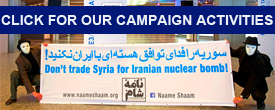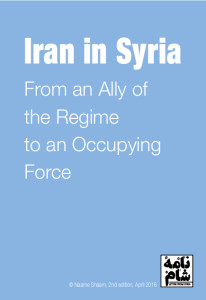 NAAME SHAAM RELEASES UPDATED REPORT ON IRAN’S ROLE IN SYRIA
NAAME SHAAM RELEASES UPDATED REPORT ON IRAN’S ROLE IN SYRIA
Iranian forces and militias are occupying parts of Syria and responsible for crimes against humanity
The Hague, 29 April 2016 – The campaign group Naame Shaam (1) today released a second, updated edition of its in-depth report “Iran in Syria: From an Ally of the Regime to an Occupying Force”.(2) The first edition was published in November 2014.
The 200-page report documents and analyzes various aspects of the military, political and economic role played in the Syria war by the Iranian regime and the militias it controls since March 2011, following the outbreak of the Syrian revolution.
The unprecedented level of military and economic support provided by Iran has not only prevented the Assad regime from collapse, but has also changed the nature of the relationship between Tehran and Damascus: from being historically mutually beneficial allies, the Iranian regime is now effectively an occupying force in the regime-held areas of Syria, and the Syrian regime is little more than a puppet in the hands of Sepah Pasdaran (Iran’s Revolutionary Guards) and its foreign operations arm, Sepah Qods.
The report also provides numerous examples and case studies of human rights violations, war crimes and crimes against humanity committed in Syria by Iranian-controlled militias and forces.
Shiar Youssef, the head of Naame Shaam’s Research and Advocacy team and the author of the report, said: “There is sufficient evidence to try the Iranian regime’s military and political leadership for complicity in many of these crimes at various levels, ranging from inciting, endorsing and adopting specific terrorist acts to aiding and abetting war crimes and crimes against humanity.”
“The only thing missing is the political will in the White House and in the European Union to do so,” he added.
This second edition of the report provides detailed updates on some of the key issues raised in the first edition:
– A new section on restructuring the notorious Syrian militia known as the National Defence Forces (NDF) provides an overview of Iranian plans to merge and restructure pro-Assad militias, both local and foreign. Particular attention is paid to efforts to form ‘Hezbollah Syria’, sometimes also called the National Ideological Resistance, which would be similar to Hezbollah Lebanon: a parallel army that is intended to safeguard the Iranian regime’s interests in Syria even after fall of the Assad regime.
– An update on Hezbollah Lebanon’s involvement in Syria details how the group’s role in the war has grown in significance and scale at the expense of Syrian regime forces. The section focuses on key battles in strategic areas described as ‘useful Syria’, and examines Sepah Pasdaran’s and Hezbollah’s efforts to establish a foothold in southern Syria as another ‘deterrence front’ with Israel.
– A subsection on Hezbollah’s recruitment efforts in Lebanon provides previously unknown details about the formation, arming and training of various pro-Iranian non-Shia militias in Lebanon, with the help of Hezbollah, as a ‘reserve pool’.
– An update on Iraqi Shia militias’ involvement in Syria examines the increasing geographical distribution and the more prominent role played by these militias in key battles across Syria.
– Similarly, an update on Afghan Shia fighters’ involvement in Syria traces how their number and role in Syria have become more prominent. The section provides new details on the origins and development of the Fatemiyoun Brigade, and new details about Iranian recruitment efforts among Afghan refugees and migrants in Iran
– A new section on Pakistani Shia fighters in Syria provides an overview of their numbers and role in the war. It also provides an overview of Pakistani casualties in Syria and the official funerals held for them in Iran. The formation of the Zaynabiyoun Brigade suggests that the number of Pakistani fighters deployed to Syria is increasing and may increase even further in the future.
– An update on the relationship between Daesh (ISIS) and the Syrian and Iranian regimes provides an overview of new reports and evidence that both regimes have infiltrated, collaborated and used Daesh and al-Qaeda-affiliated groups to serve their own interests. The section also criticises the US administration for overlooking Iran’s relationship with al-Qaeda and the US’s de facto partnership with Iran and Iranian-controlled militias in Iraq in the battle against Daesh.
– An update on Iranian fighters in Syria provides estimates of Sepah Qods and Basij members killed in Syria. This section also provides details of the arrival of hundreds of new Iranian fighters in Syria at the end of 2015 to take part in ground battles, backed by Russian air strikes.
– An update on the role of Iranian general Qassem Soleimani, the commander-in-chief of Sepah Qods and the de facto ruler of Syria, provides an overview of his recent activities and appearances in Syria. The section also reveals that Jihad Moghniyeh, the Lebanese Hezbollah operative who was killed in an Israeli strike in southern Syria in January 2015, was Soleimani’s nephew.
– An update on the economic costs of the war in Syria to Iran and Hezbollah provides new, up-to-date figures and details of how much the war in Syria is costing Iran and the impact this is having on the Iranian economy, ordinary Iranians and Hezbollah.
– Similarly, an update on the human costs of the war in Syria to Iran and Hezbollah provides an overview of recent Iranian and Hezbollah casualties. The section is supplemented with appendices listing the names of hundreds of Iranian, Afghan and Pakistani Shia fighters killed in Syria documented by Naame Shaam.
– A new section on the Russian military intervention in Syria discusses its motivations, aims and possible outcomes. It argues that the Russian intervention has in fact consolidated the Iranian regime’s control in Syria, rather than countering it. The report also provides an overview of the human and financial costs to Moscow, and concludes that Syria is likely to become “Russia’s second Afghanistan,” just as it has become “Iran’s and Hezbollah’s Vietnam.”
Fouad Hamdan, Naame Shaam’s Campaigns Director, said: “A lot has changed in Syria and the wider region since the first edition of the ‘Iran in Syria’ report was published in November 2014. Yet a lot has also remained unchanged.”
“US President Barack Obama is still insisting on following his disastrous policy of ‘slowly bleeding Iran and Hezbollah in Syria’ at the expense of continued bloodshed in Syria and rising extremism and instability in the region.”
Naame Shaam calls on the US and its allies to treat the war in Syria as an international armed conflict that involves a foreign occupation by Iran and Russia on the one hand, and a liberation struggle by the Syrian people against this foreign occupation on the other.
The US and its allies should also support referring the situation in Syria to the International Criminal Court (ICC) in The Hague to investigate all war crimes and crimes against humanity committed in Syria.
At the same time, Russia should be pressured with more economic sanctions and diplomatic isolation so that it disengages from Iran and becomes part of the solution in Syria, rather than being part of the problem.
President Obama should also fulfill his promises by arming and training enough moderate Syrian rebels, not only to fight Daesh and al-Qaeda-linked groups, but also Syrian and Iranian regime forces and militias. No-fly zones to protect civilians and allow humanitarian access throughout Syria should be enforced, in line with the international ‘responsibility to protect’ norm.
“Whether we like it or not,” Hamdan added, “only the US can prevent Syria and the Middle East from further disintegration and chaos. Only the US can lead a serious international coalition that can help Syrians build a democratic state where the rule of law prevails, and where there is no place for al-Assad and his supporters.”
Notes for editors:
1. Naame Shaam is a group of Iranian, Syrian and Lebanese activists and citizen-journalists that focuses on uncovering the role of the Iranian regime in Syria. Naame Shaam means “Letter from Syria” in Persian. For more details about the group and its activities, see www.naameshaam.org.
Naame Shaam is part of the Netherlands-based Rule of Law Foundation, www.lawrules.org.
(2) The full report “Iran in Syria: From an Ally of the Regime to an Occupying Force” can be found at: http://www.naameshaam.org/iran-in-syria-2016/.
(3) In December 2015, Naame Shaam published a report entitled “Financing Terror – The Economic Impact of Iran’s Nuclear Programme and its Support to Paramilitary Groups across the Middle East”. It details Iran’s lavish expenditure on financing terrorist activities and groups in Lebanon, Iraq, Syria, Palestine and Yemen, which has totaled up to US$ 80 billion since the 1980s.
In May 2015, Naame Shaam published another report entitled “Silent Sectarian Cleansing: Iranian Role in Mass Demolitions and Population Transfers in Syria”. The report accuses the Assad regime and its Iranian and Hezbollah Lebanon backers of systematic forced displacement of Syrian civilians and the destruction and appropriation of their property in certain parts of Syria, such as Damascus and Homs.
 English
English  فارسی
فارسی  العربية
العربية 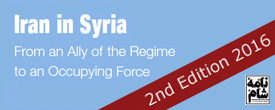
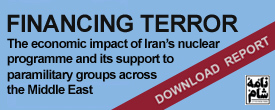
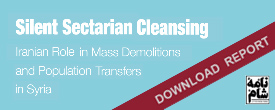
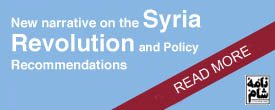

 On Twitter
On Twitter